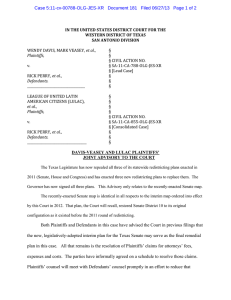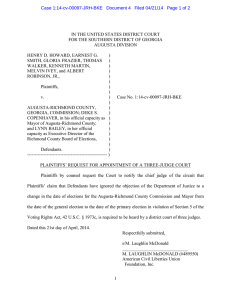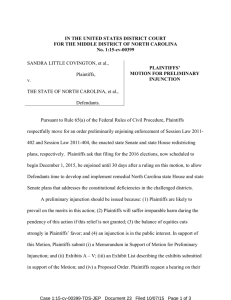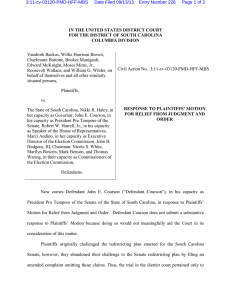Document 10742115
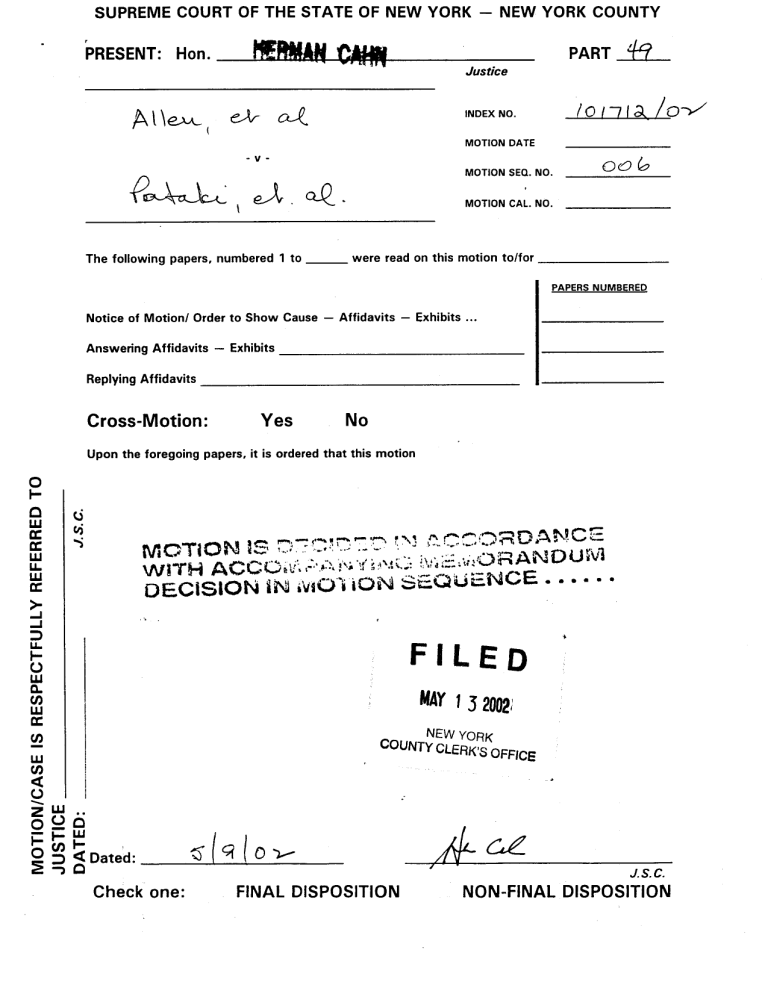
SUPREME COURT OF THE STATE OF NEW YORK - NEW YORK COUNTY
PRESENT: PART +?
Justice
.
INDEX NO.
MOTION DATE
MOTION SEQ. NO.
MOTION CAL. NO.
oob
The following papers, numbered 1 to were read on this motion to/for
PAPERS NUMBERED
Notice of Motion/ Order to Show Cause - Affidavits - Exhibits . . .
Answering Affidavits - Exhibits
Replying Affidavits
Cross-Motion: Yes
Upon the foregoing papers, it is ordered that this motion ii!
Y
CT z
4 i
SW
0gii qj$
p 3
_) g Dated:
Check one: FINAL DISPOSITION
NEW YORK
COUNTY CLERK’S OFFICE
*
J. S. C.
NON-FINAL DISPOSITION
'SUPREME COURT OF THE STATE OF NEW YORK
COUNTY OF NEW YORK:
_________-
PART 49
-_--_-_---x
HOWARD T. ALLEN, ERIC RODRIGUEZ, MARTIN
MALAVE-DILAN, JEANNETTE SANTOS, DONALD
J. JIRAK, RICHARD FLATEAU; CHARLOTTE A.
TAYLOR, MERVYN A. CAMPBELL, SARAH
BROCKUS, PATRICIA MCDOW, LISA BEST,
VICTOR OLUWOLE, RUBEN RANGEL, IRIS
PELLERANO, RUSSELL VELAZQUEZ, GUILLERMO
LINARES, ISABEL EVANGELISTA, MARTHA L.
PEPIN, MARISEFA REYES, MARIA URENA,
TYRONE ZIMMERMAN, JOSE ALVARADO, IRVIN
MCMANUS, WAYNE HALL, SAMUEL PRIOLEAU,
WILLIAM RODRIGUEZ, NEVILLE MULLINGS,
MARY ADAMS, EUGENE A. BURNETT, SR.,
HAZEL PALMORE, JOHNNY W. VELEZ, JUDITH
CRUZ,
Plaintiffs,
-against-
Index No.
101712/02
GEORGE E. PATAKI, Governor of the State of New York, MARY 0. DONOHUE, Lt. Governor and President of the Senate of the State of New York, ELIOT SPITZER, Attorney General of the State of New York, JOSEPH L. BRUNO,
President Pro Tempore and Majority Leader of the Senate of the State of New York,
SHELDON SILVER, Speaker of the Assembly of the State of New York, MARTIN E. CONNOR,
Minority Leader of the Senate of the State of New York, CHARLES NESBITT, Minority
Leader of the State of New York, and CAROL
BERMAN, NEIL W. KELLEHER, HELENA M. DONOHUE and EVELYN J. AQUILA, Commissioners of the
New York State Board of Elections,
Defendants.
- - - _ --- -__- - - ____- -_
-X
CAHN, J.:
This action challenges, inter alia, the redistricting plan fcr the New York State Senate (the "Senate Plan"), which was signed into law by the Gcvernor on April 24, 2002.l
1
No challenge is redistrictLng plan which pcsed kerein t o the State Assembly
*tias enacted as part of the same statute.
Plaintiffs move for a preliminary injunction on their first cause of action under the Equal Protection Clause of the
Fourteenth Amendment, to enjoin defendants from proceeding with the 2002 elections for the New York State Senate pursuant to the
Senate Plan, and seek to compel the creation of an alternate, court-approved redistricting plan.
The New York State Attorney
General 'opposes the motion, joined by President Pro Tempore of the State Senate Joseph Bruno.
Pursuant to the 2000 Census, New York State's population is
18,976,457, an increase of 5.5% over 1990.
In response to the
Census, the New York State Legislature enacted, on April 10,
2002, a reapportionment plan for the State Senate which created
62 voting districts.
Accordingly, the l'ideal" population of each district for equal representation purposes would be
18,976,457 divided by 62, or 306,072 persons.
According to plaintiffs, the districts range in size from
290,925 to 320,851.
The Amended Complaint alleges that the deviation between the smallest and largest districts is 9.78% of the ideal population, and that the average deviation from the ideal is 2.22%.
Plaintiffs contend that this degree of deviation is so great that it could not have resulted from an honest, good faith effort to achieve population equality between districts.
In particular, plaintiffs allege a geographic bias which uniformly fa-Iors upstate districts by underpopulating them and disfavors dc-,rnstate districts by overpopulating them.'
2
Suffolk
Flair-tiffs' definition of "downstate" excludes Nassau and counries, and includes Rockland County and par= of Orange
County.
2
I
Plaintiffs also note that the disparities in district size under past Senate plans were not as great, with total deviations of
1.83% in 1972, 5.30% in 1982 and 4.29% in 1992, and average deviations of .12% in 1972, .83% in 1982, and .90% in 1992.
The motion for preliminary relief is denied.
"The drastic remedy of a preliminary injunction is appropriate only where the moving party has established a likelihood of success on the merits, irreparable injury in its absence of such relief and a balancing of the equities in its favor" (Aoolication of Non-
Emerqencv Transporters of New York v Hammons, 249 AD2d 124 [lst
Dept 19981; see Koultukis v Phillins, 285 AD2d 433 [lst Dept
20011; East 13th St.Homesteader' Coalition v Lower East Side
Coalition of Housins Dev., 230 AD2d 622 [lst Dept 19961; W.T.
Grant Co. v Srosi, 52 NY2d 496 [1981]).
Furthermore, "[a] preliminary injunction is a provisional remedy . . .
[ilts function is not to determine the ultimate rights of the parties, but to maintain the status quo until there can be a full hearing on the merits" (Residential Bd. Of Mqrs. of the Columbia
Condominium v Alden, 178 AD2d 121, 122 [lst Dept 19911; see
Morris v Port Auth.
of New York and New Jersey, 290 AD2d 22 [lst
Dept 20021).
Given the great deference to which districting legislation is entitled, and the disruption of the status quo that judicial interference into the state electoral process would necessarily create, the court finds that neither injunctive relief nor an expedited trial of this matter is warranted.
First, without adj-Ldicating the merits of plaintiffs' claims, it :ust nevertheless Se noted that "[a] strong
3
presumption of constitutionality attaches to [al redistricting plan" (Matter of Wolooff v Cuomo, 80 NY2d 70, 78 [1992]). A court "may upset the balance struck by the Legislature and declare the plan unconstitutional only when it can be shown beyond reasonable doubt that it conflicts with the fundamental law, and that until every reasonable mode of reconciliation of the statute with the Constitution has been resorted to, and reconciliation has been found impossible"
(Id.)
(internal quotations and citations omitted).
Furthermore, because
"[blalancing the myriad requirements imposed by both the State and the Federal Constitution is a function entrusted to the
Legislature . . .
[iIt is not the role of [any court] to secondguess the determinations of the Legislature, the elective representatives of the people, in this regard" (Id. at 79).
In view of these standards, to demonstrate a likelihood of success on the merits plaintiffs must establish "beyond reasonable doubt" that the Senate Plan is unconstitutional.
Significantly, the debate between the parties on this issue has centered not upon whether plaintiffs have met that high standard, but upcn whether a lesser standard of stating a prima facie case has been met.
Defendants note, and plaintiffs agree, that at least as a general matter, under federal law a total population variance of less than ten percent renders a state reapportionment plan prima facie constitutional (see, e.g.,
Voinovich v Ouilter, 507 US 146 [1993]; Brown v Thompson, 462 US
835 119831; Conner v Finch, 431 US.407 [1997]; ilhite v Reqester,
412 CS 755 [1973]!; Fund for Accurate & Infcrmed Reoresentation v
4
Weprin, 796 F Supp 662 [NDNY] [three-judge panel] [finding that
1992 New York State Assembly plan with total population deviation of 9.43% was constitutional under ten percent rule], affd 506 US
1017 [1992]).
While plaintiffs argue that the ten percent rule is not absolute, and that a variety factors -- the relatively high 9.78% total deviation, the higher than
usuai
mean deviations, alleged Census undercounting and defendants' bad faith -- should permit an exception to the rule, these arguments fall short of convincing the court that the matter is beyond reasonable doubt.
The courts have been especially reluctant to find irreparable harm, and to intervene in the state electoral process, in cases such as this where the constitutional violation is not manifestly clear.
Rather, the harm to the public interest from delaying an electicn, and the prejudice and confusion to voters, candidates and election officials has been found to outweigh the potential benefits of injunctive relief (see,
Revnolds v Sims, 377 US 533,
585 [1964]["[i]n awarding or withholding immediate relief, a court is entitled to and should consider the proximity cf a forthcoming election and the
[the mechanics and complexities of state election laws . . .
court should] avoid a disruption of the election process which might resulr from requiring precipitate changes"]) Diaz v Silver,
932 F Supp 452, 465-66, 68
[ECNY 1996][three-judge panel] ["a preliminary injuncticn enjoining" electoral processes "is an extraordinary remedy involving the exercise
GZ
a very farreaching pc>;er . . .
[claution is especially necessary because if
5
_ an injunction is granted . . .
[the] court would be interrupting a state's election process . . .
the harm to the public . . .
outweighs the likely benefit to the plaintiffs of granting a preliminary injunction"]; Ashe v Bd.
Of Elections of the City of
New York 1988 WL 68721 [EDNY 1988[three-judge panel] [citing "the public interest in maintaining an orderly system of registration and in holding a primary election on a regularly scheduled date"]) .
Indeed, even where the districting plan has been found to be infirm, the courts have permitted elections to go forward subject to later corrective action (see,
Whitcomb v Chavis, 396
US 1055 and 396 L?S 1064 [1970]; Dillard v Crenshaw County, 640 F
Supp 1347 [MD Ala 19861; Watkins v Maaus, 771 F Supp 739, 801-05
[SD Miss 1991][three-judge panel][t'where, as here, the possibility of corrective relief at a later date exists, even an established Voting Rights Act violation dces not in and of itself merit a preliminary injuncticn"], aff'd & part and vacated in
, 502 us 954 [1951]).
Nor does it appear that pursuing an expedited resolution of this action, in advance of the next election cycle, wculd be the most prudent course of action.
Given the presumed constitutionalit: of t?e redistricting statute, the importance and complexity cf the issues raised (especially in connection with plaintiffs and inzervencrs'
Vccing Rights Acts claims), the public interest ;<ould not be served bTy a ?_asty and precipitous consideration of the various claims.
Ratker, t c the extent zhat any of the claims cannct be resolved as a matter of la-~, the
"action [sh]culC be subjected to the normal lit_:gation procedures
6
. ,of pretrial motions, discovery, and direct and cross-examination of witnesses, all unhampered by the severe time constraints imposed" by the upcoming the primary and general election campaign periods (Puerto Rican Legal Defense and Educ. Fund, Inc.
v Gantt, 796 F Supp 698, 700 [EDNY 1992][three_judge panel]).
Accordingly, it is
ORDERED, that the motion for a preliminary injunction is denied.
The court will convene a preliminary conference to consider discovery and other proceedings, on June 6, 2002, at 11:OO AM, at
IA Part 49, 60 Centre Street, New York, N.Y., Room 232.
Dated: May , 2002
ENTER:
. . .
7
